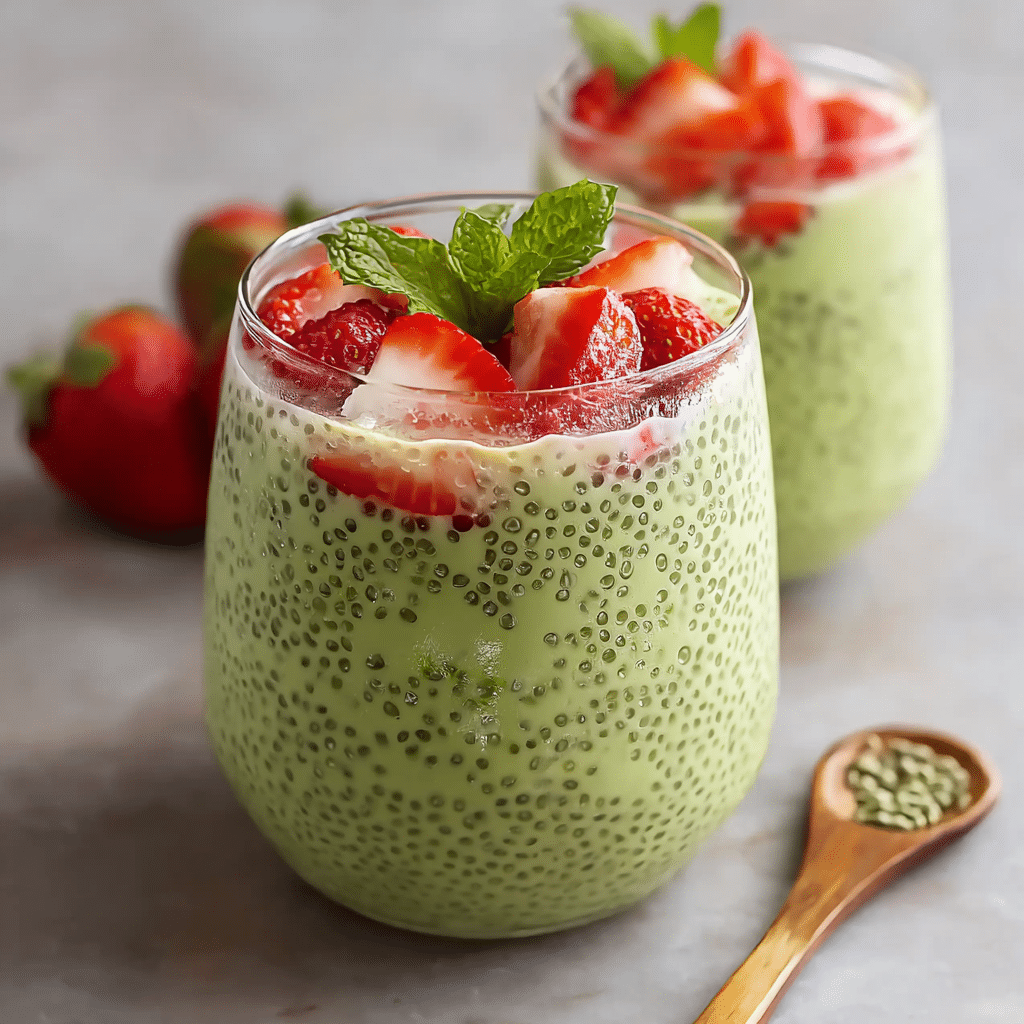The Strawberry Matcha Sago Delight is a refreshing and visually stunning dessert that fuses sweet strawberries, creamy coconut milk, and earthy matcha for a layered experience in both flavor and texture. Inspired by Asian dessert culture, this glass parfait is perfect for warm days when you need something light yet satisfying.
Each spoonful brings a burst of flavors—the fruity tang of strawberries, chewy sago pearls, and the bitter-smooth balance of matcha—elevated by the richness of coconut and the optional touch of condensed milk. Whether you’re serving guests or treating yourself, this beautifully vibrant dessert will leave a lasting impression with every chilled bite.
Full Recipe
Ingredients:
-
1/3 cup sago pearls
-
2 cups water (for boiling sago)
-
1/2 cup strawberries, chopped
-
1 tablespoon sugar (optional)
-
1/2 cup hot water (for matcha)
-
1 teaspoon matcha powder
-
1/2 cup coconut milk
-
1 tablespoon condensed milk (optional)
-
Ice cubes or crushed ice (optional for serving)
-
Mint leaves and extra strawberries for garnish
Directions:
-
Boil 2 cups of water in a medium saucepan. Add the sago pearls and cook for 10–15 minutes, stirring occasionally until the sago becomes mostly translucent with a small white dot in the center.
-
Turn off the heat, cover the saucepan with a lid, and let sit for 5–10 minutes to allow the sago to become fully translucent.
-
Drain the cooked sago through a fine mesh strainer and rinse under cold water to remove excess starch. Set aside.
-
In a blender, add the chopped strawberries and sugar (if using). Blend until smooth.
-
In a small bowl, whisk matcha powder with 1/2 cup of hot water until fully dissolved and smooth.
-
Mix coconut milk and condensed milk in another bowl. Adjust sweetness to taste.
-
To assemble: In a glass, layer strawberry puree at the bottom, followed by sago pearls, then pour in the matcha mixture. Top with the coconut milk layer.
-
Add ice cubes or crushed ice if desired. Garnish with mint leaves and extra chopped strawberries.
-
Serve chilled and enjoy!
Prep Time: 15 minutes | Cooking Time: 15 minutes | Total Time: 30 minutes
Kcal: 180 kcal | Servings: 2 servings
A Harmony of Cultures in a Single Glass
Strawberry Matcha Sago Delight is not just a pretty dessert layered in a cup — it’s a thoughtful fusion of ingredients that trace their roots across continents. It brings together the earthy elegance of Japanese matcha, the tropical silkiness of Southeast Asian coconut milk, and the universally loved sweetness of strawberries. In a single serving, this dessert showcases harmony, simplicity, and a celebration of flavor contrasts. Its appeal lies not just in its vibrant aesthetics, but also in how it delights the palate in gentle, refreshing layers.
This dessert has become a favorite not only among food enthusiasts looking for modern twists but also those interested in plant-based or gluten-free treats. It fits effortlessly into diverse diets while offering a sensory experience that’s both nourishing and indulgent.
The Global Story Behind the Ingredients
Sago, the base of this dish, has long been used in tropical Asia and the Pacific Islands. It’s a starch extracted from the pith of palm stems and has been an essential source of carbohydrates for centuries. Its jelly-like texture when cooked is not only satisfying to chew but also serves as a neutral base that readily takes on the surrounding flavors — in this case, matcha, strawberry, and coconut.
Matcha, the powdered green tea from Japan, has risen in global popularity in recent years but has been cultivated and consumed in Japan since the 12th century. Its deep umami flavor, bitter complexity, and subtle sweetness make it a perfect contrast to the juicy brightness of strawberries. Matcha is not just a flavor but a cultural emblem — tied to mindfulness, tradition, and wellness.
Strawberries, while grown and eaten worldwide, are typically associated with freshness, love, and spring. Their bright color and natural sweetness make them ideal for blending into desserts. When paired with matcha, they offer a delicious balance of acidity and sweetness.
Coconut milk, used widely in tropical cuisines, especially in Thailand, Indonesia, Malaysia, and the Philippines, lends this dish its creamy richness. Coconut complements both matcha and strawberries, acting as the unifying flavor that ties all the components together.
Why This Dessert Works
What makes the Strawberry Matcha Sago Delight so special is its balance of temperatures, textures, and tastes. The coolness of the dessert refreshes the palate on hot days. The chewy sago contrasts beautifully with the creaminess of coconut milk and the smoothness of pureed strawberries. The bitterness of matcha is balanced by the natural sweetness of condensed milk or fruit, depending on how you choose to customize it.
This dessert isn’t overly sweet, which allows the natural flavor of each ingredient to shine through. The layering also gives you the freedom to mix or enjoy each component on its own, making every bite just a little different from the last.
Nutritional Highlights and Dietary Considerations
The Strawberry Matcha Sago Delight is more than just a pretty dessert — it’s also a mindful choice for many diets:
-
Gluten-Free: Sago is naturally gluten-free, making it safe for those with gluten sensitivities or celiac disease.
-
Dairy-Free (Optional): By omitting the condensed milk or replacing it with a dairy-free alternative, this dessert can be made entirely plant-based.
-
Antioxidant-Rich: Matcha is known for its high antioxidant content, particularly catechins like EGCG, which support immune function and may help combat oxidative stress.
-
Fiber and Vitamin C: Strawberries contribute vitamin C and dietary fiber, adding a nutritional boost while supporting skin health and digestion.
-
Hydration-Friendly: Coconut milk helps keep you hydrated and adds healthy fats that aid in nutrient absorption.
This makes the dessert not only suitable for modern wellness trends but also genuinely nourishing when enjoyed in moderation.
The Aesthetic Appeal of Layered Desserts
Layered desserts have always had a charm of their own. They invite the eye before they please the tongue. Strawberry Matcha Sago is often served in transparent cups or glasses so each layer can be admired. The bold green of the matcha, the creamy white of coconut, and the pink-red of the strawberry create a visual experience as striking as the taste.
For content creators, food bloggers, and social media enthusiasts, this dessert is highly photogenic — the kind of dish that’s shared widely across Instagram, Pinterest, and food blogs. Its natural colors and defined layers make it ideal for flat-lay shots or bright natural-light photography.
Variations and Customizations
One of the joys of this dessert is how adaptable it is:
-
Tropical Twist: Swap strawberries for mango or passionfruit puree.
-
Extra Crunch: Add roasted coconut flakes or crushed pistachios on top for texture.
-
Herbal Notes: Infuse the coconut milk with pandan leaves or basil seeds for added flavor depth.
-
Different Milks: Try almond milk, soy milk, or oat milk for vegan versions that cater to different taste preferences.
You can also control the sweetness by adjusting how much sugar or condensed milk you add. This is especially helpful if you’re catering to dietary restrictions or simply prefer a more subtle dessert.
Serving Suggestions
This dessert is best served chilled, ideally after at least 30 minutes in the fridge. It’s perfect for:
-
Summer Parties: Its refreshing coolness and striking presentation make it a hit at outdoor gatherings.
-
Afternoon Tea: Pair it with light savory snacks for a unique Asian-inspired tea party.
-
Post-Dinner Treat: Serve in small glasses as an elegant conclusion to an Asian or fusion meal.
To elevate the serving experience, consider garnishing with mint leaves, edible flowers, or even a dusting of matcha powder on top. Glass jars or layered dessert bowls work beautifully for presentation, especially if you’re serving guests or showcasing your work online.
Cultural Crossover: Modern Asian Desserts
Desserts like this highlight the growing trend of Asian fusion desserts that embrace traditional ingredients while exploring new textures, presentations, and flavor profiles. In many Southeast Asian countries, sago desserts are traditionally served warm with coconut and palm sugar. In this variation, however, the elements are modernized: blended fruits, layered presentation, and chilled for maximum refreshment.
It also reflects the culinary creativity seen in bubble teas, shaved ice bowls, and layered fruit-coconut drinks found in cafes from Bangkok to Seoul to Los Angeles.
Conclusion: A Modern Classic in the Making
Strawberry Matcha Sago Delight may have humble, traditional roots, but it’s undeniably modern in execution. It represents a culinary harmony — a fusion of flavors, textures, and cultures — that makes it both nostalgic and innovative. It’s health-conscious yet indulgent, simple yet sophisticated, and visually arresting in every sense.
Whether you’re a seasoned foodie, a dessert lover, or someone exploring global flavors, this dessert delivers on every level. It’s a beautiful reminder that the best dishes are those that connect us — to memories, to tradition, and to one another.
Serve it chilled, savor it slowly, and don’t forget to snap a picture before diving in. You’ve just made a dessert that’s as soulful as it is stunning.






